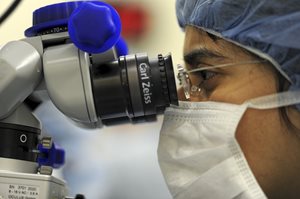Technologies
 Optics and photonics greatly enhance the United States’ ability to gather intelligence, defend its citizens and protect its troops in the field. Optical sensing technology makes surveillance and reconnaissance possible and it identifies chemical, biological and nuclear threats to the homeland.
Optics and photonics greatly enhance the United States’ ability to gather intelligence, defend its citizens and protect its troops in the field. Optical sensing technology makes surveillance and reconnaissance possible and it identifies chemical, biological and nuclear threats to the homeland.Photonics makes laser-guided weapons more accurate, provides lasers for critical missile defense capabilities and permits personalized use of flexible display technology, which allows our men and women in uniform to remain informed and safe during operations with night vision, GPS and physiological feedback. Coordinated investment and associated technology development in remote sensing, photonic integrated circuit manufacturing, advanced lasers and cyber security will ensure future military and economic security.
 From laser eye surgery to CT scans, photonics is responsible for medical advances that save and dramatically improve millions of US lives. Photonics plays a key role in next-generation health care, both in enhancing the ability to observe and measure symptoms and the capability to treat patients earlier with less invasive, more cost effective methods.
From laser eye surgery to CT scans, photonics is responsible for medical advances that save and dramatically improve millions of US lives. Photonics plays a key role in next-generation health care, both in enhancing the ability to observe and measure symptoms and the capability to treat patients earlier with less invasive, more cost effective methods.Photonics-based health care tools offer sensitivity, precision, speed, and accuracy, which enable rapid diagnosis and effective therapy — key ingredients for high-quality, cost-effective care. Further investment in bio photonics will result in smaller, more portable, automated, point-of-care diagnostic devices that have the potential to improve outcomes and the ability to reach patients who, because of location, income or other factors, lack access to health care.
 Photonics increases the efficiency and safety of US energy production and consumption. The renewable energy sector is an area of potentially significant job growth and a space in which photonics research can help lower US energy consumption and reduce our reliance on foreign oil, thus strengthening national security and revitalize the US economy.
Photonics increases the efficiency and safety of US energy production and consumption. The renewable energy sector is an area of potentially significant job growth and a space in which photonics research can help lower US energy consumption and reduce our reliance on foreign oil, thus strengthening national security and revitalize the US economy.Renewable energy technologies are especially attractive since most energy sources depend on fossil fuels, a limited resource that can be dangerous to extract and harmful to the environment. The oil and gas industry, for example, increasingly uses optical systems to monitor wells, thereby increasing production and mitigating risks. Additionally, solid-state lighting, such as LEDs, developed through photonics research, could cut US lighting electricity usage by about 45 percent by 2030, with forecasted energy savings of $30 billion dollars at today’s energy costs and a reduction of greenhouse gas emissions equivalent to 40 million cars.
Global demand for new energy sources represents a significant growth opportunity for US manufacturers and producers. US companies will need continued research and development investments and structural support to lead the world into a clean, secure, efficient energy future.
Advanced manufacturing is vital for the economic well-being of the country; it is a sector in which substantial job growth is possible. Though the majority of display and photonics component manufacturing has moved overseas, the United States can be a leader in new and innovative areas of manufacturing involving a new generation of high-power and low-cost ultra short pulsed lasers, as well as additive manufacturing, also known as 3D printing.
Additive manufacturing allows machines to make a range of customized products directly from electronically transmitted designs, saving costly material in the process. These advanced printers, which US President Barack Obama called the future of manufacturing, can create objects ranging from prosthetic limbs and functional human tissue to jet engine parts and shoes. While the United States may struggle to compete successfully in high-volume, labor-intensive, low-cost manufacturing, our nation can be a strong competitor in custom, precision and high added-value manufacturing.
Additive manufacturing allows machines to make a range of customized products directly from electronically transmitted designs, saving costly material in the process. These advanced printers, which US President Barack Obama called the future of manufacturing, can create objects ranging from prosthetic limbs and functional human tissue to jet engine parts and shoes. While the United States may struggle to compete successfully in high-volume, labor-intensive, low-cost manufacturing, our nation can be a strong competitor in custom, precision and high added-value manufacturing.
The next time you send an e-mail, Skype with your family or post on Twitter, remember that without photonics, the Internet as we know it would not exist. Optics and photonics increased the capacity of the Internet by nearly 10,000-fold over the past two decades. Bandwidth demand is expected to grow another 100-fold, and possibly more, over the next 10 to 20 years.
Without improvements to address the cost, power consumption, data rate and size, demand will outstrip capacity, which may lead to higher costs and possibly even constrain the greater US and global economy. Those countries that invest in solving these challenges will gain a sizeable national security advantage by advancing the infrastructure that enables our Internet-based economy.
Without improvements to address the cost, power consumption, data rate and size, demand will outstrip capacity, which may lead to higher costs and possibly even constrain the greater US and global economy. Those countries that invest in solving these challenges will gain a sizeable national security advantage by advancing the infrastructure that enables our Internet-based economy.